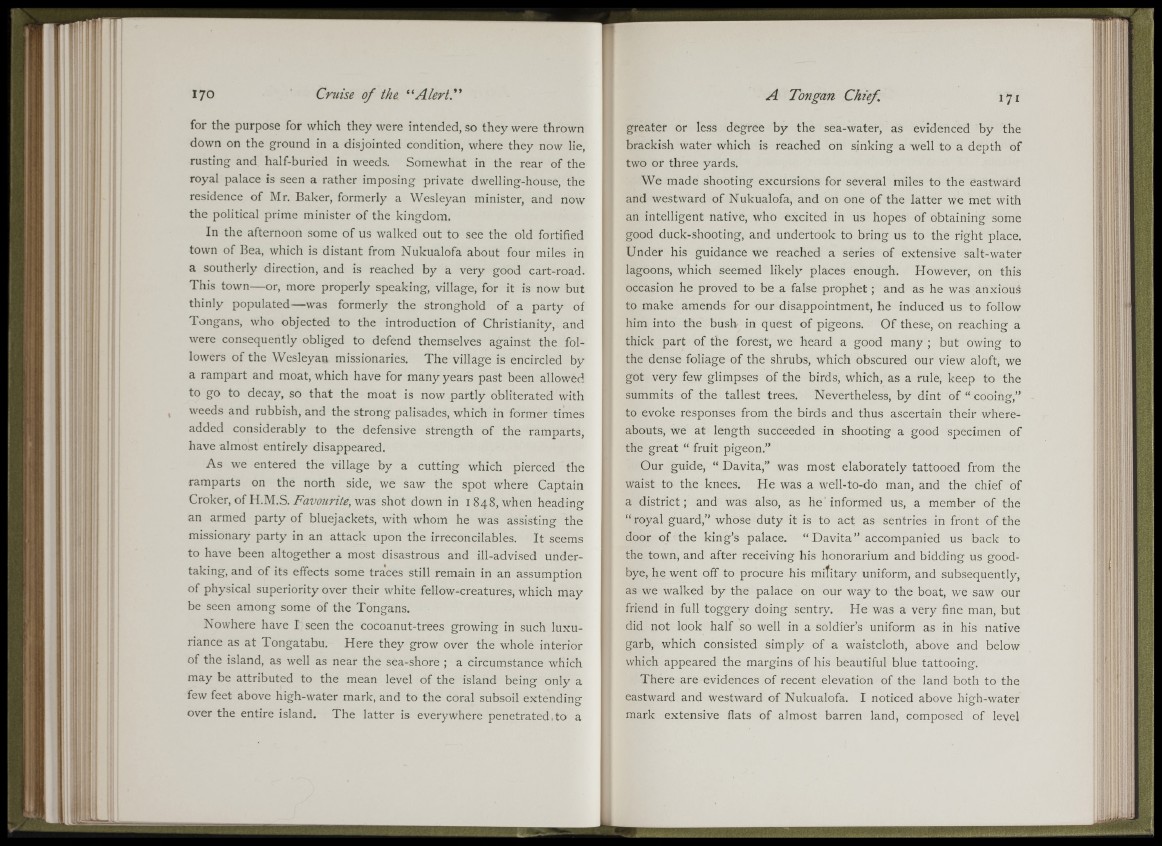
170 Cruise of the “Alert.”
for the purpose for which they were intended, so they were thrown
down on the ground in a disjointed condition, where they now lie,
rusting and half-buried in weeds. Somewhat in the rear of the
royal palace is seen a rather imposing private dwelling-house, the
residence of Mr. Baker, formerly a Wesleyan minister, and now
the political prime minister of the kingdom.
In the afternoon some of us walked out to see the old fortified
town of Bea, which is distant from Nukualofa about four miles in
a southerly direction, and is reached by a very good cart-road.
This town— or, more properly speaking, village, for it is now but
thinly populated— was formerly the stronghold of a party of
Tongans, who objected to the introduction of Christianity, and
were consequently obliged to defend themselves against the followers
of the Wesleyan missionaries. The village is encircled by
a rampart and moat, which have for many years past been allowed,
to go to decay, so that the moat is now partly obliterated with
weeds and rubbish, and the strong palisades, which in former times
added considerably to the defensive strength of the ramparts,
have almost entirely disappeared.
As we entered the village by a cutting which pierced the
ramparts on the north side, we saw the spot where Captain
Cxdker,oiYlM.S. Favourite, wdtS shot down in 1848, when heading
an armed party of bluejackets, with whom he was assisting the
missionary party in an attack upon the irreconcilables. It seems
to have been altogether a most disastrous and ill-advised undertaking,
and of its effects some traces still remain in an assumption
of physical superiority over their white fellow-creatures, which may
be seen among some of the Tongans.
Nowhere have I seen the cocoanut-trees growing in such luxuriance
as at Tongatabu. Here they grow over the whole interior
of the island, as well as near the sea-shore ; a circumstance which
may be attributed to the mean level of the island being only a
few feet above high-water mark, and to the coral subsoil extending
over the entire island. The latter is everywhere penetrated to a
A Tongan Chief.
greater or less degree by the sea-water, as evidenced by the
brackish water which is reached on sinking a well to a depth of
two or three yards.
We made shooting excursions for several miles to the eastward
and westward of Nukualofa, and on one of the latter we met with
an intelligent native, who excited in us hopes of obtaining some
good duck-shooting, and undertook to bring us to the right place.
Under his guidance we reached a series of extensive salt-water
lagoons, which seemed likely places enough. However, on this
occasion he proved to be a false prophet; and as he was anxious
to make amends for our disappointment, he induced us to follow
him into the bush in quest of pigeons. Of these, on reaching a
thick part of the forest, we heard a good many ; but owing to
the dense foliage of the shrubs, which obscured our view aloft, we
got very few glimpses of the birds, which, as a rule, keep to the
summits of the tallest trees. Nevertheless, by dint of “ cooing,”
to evoke responses from the birds and thus ascertain their whereabouts,
we at length succeeded in shooting a good specimen of
the great “ fruit pigeon.”
Our guide, “ Davita,” was most elaborately tattooed from the
waist to the knees. He was a well-to-do man, and the chief of
a district; and was also, as he informed us, a member of the
“ royal guard,” whose duty it is to act as sentries in front of the
door of the king’s palace. “ Davita” accompanied us back to
the town, and after receiving his honorarium and bidding us goodbye,
he went off to procure his military uniform, and subsequently,
as we walked by the palace on our way to the boat, we saw our
friend in full toggery doing sentry. He was a very fine man, but
did not look half so well in a soldier’s uniform as in his native
garb, which consisted simply of a waistcloth, above and below
which appeared the margins of his beautiful blue tattooing.
There are evidences of recent elevation of the land both to the
eastward and westward of Nukualofa. I noticed above high-water
mark extensive fiats of almost barren land, composed of level
hill